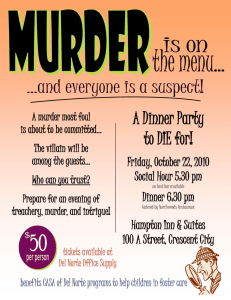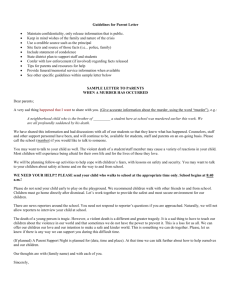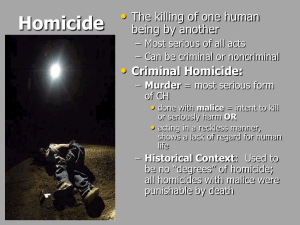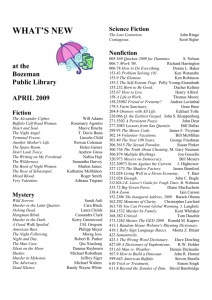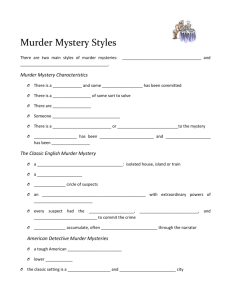Murder and Robbery
advertisement
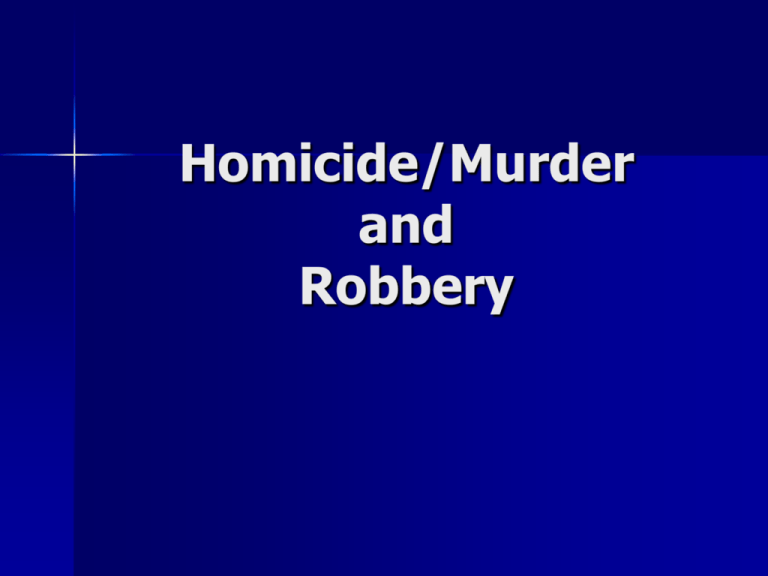
Homicide/Murder and Robbery Murder ̶ Defined Defined as the unlawful killing of a human being with malice aforethought Typical criminal code language – A person who kills an individual without lawful justification commits murder if, in performing the acts that cause the death: He either intends to kill or do great bodily harm He knows that such acts create a strong probability of death or great bodily harm He is attempting or committing a forcible felony other than voluntary manslaughter The Legal Definition of Homicide Homicide is defined as the killing of a human by another human The common notion that homicide and murder are synonymous is false – The difference lies in the legality of the death – The question is the presence or absence of criminality Homicide can be justifiable or excusable – – – – State executions Arrests by the police in some circumstances Self-defense War Criminal Homicide The act is murder if the wrongdoer accomplishes the crime with premeditation The act is frequently referred to as a premeditated design to kill The state must prove that the accused consciously intended to kill the victim Wisconsin’s definition: – 940.01 (1)(a) First-degree intentional homicide. Whoever causes the death of another human being with intent to kill that person or another is guilty of a Class A felony Criminal Homicide (continued) Premeditation does not always imply the existence of an elaborate plan – The time frame is not important (not defined in minutes, hours, or days) – The fact that the design to kill was present before the act is critical Murder can be accomplished without premeditation ̶ two examples: – A criminal homicide can constitute murder even when premeditation to kill is lacking altogether When perpetrated by any act imminently dangerous to another Evincing a depraved mind regardless of human life – If the killing occurs during the commission of a felony (felony murder) The FBI’s Uniform Crime Reporting (UCR) Program defines murder and nonnegligent manslaughter as the willful (nonnegligent) killing of one human being by another. The classification of this offense is based solely on police investigation as opposed to the determination of a court, medical examiner, coroner, jury, or other judicial body. The UCR Program does not include the following situations in this offense classification: deaths caused by negligence, suicide, or accident; justifiable homicides; and attempts to murder or assaults to murder, which are scored as aggravated assaults. According to the UCR, in 2012, an estimated 14,827 persons were murdered in the United States. This was a 1.1 percent increase from the 2011 estimate, but a 9.9 percent decrease from the 2008 figure, and a 10.3 percent drop from the number in 2003. Murder in Degrees Many states have assigned varying degrees to the crime of murder – First degree Typically includes premeditated murder – Second degree An act creating a strong probability of harm, which results in death – Third degree Deaths that result during the perpetration (or attempt) of a felony Current State of Criminal Homicide Accurate statistics are compiled by the FBI’s The current U.S. annual rate of criminal homicide is more than 14,000 Uniform Crime Report – Indicates a significant decrease of this serous violent crime in the last seven years – Homicide accounts for only about 1% of the total violent crime – The decade rate of homicide is historically very high Surpassing even the murder rates experienced during the violent Prohibition era of the 1920s and 1930s Chicago’s homicide rates are nearly triple the frequency encountered during the city’s murderous gangland period during prohibition Why So Many Murders? – – – – – – – – The relationship of drugs to murder is unmistakable The rapid growth of drug gangs, particularly those dealing in cocaine Washington, D.C. officials reported that 41% of all homicides were drug-related 56% of the killings in Savannah, Georgia were similarly connected to drugs The greatest frequency of murder occurs: During July and August On holidays On weekends During evening and night hours In southern states In large metropolitan areas Victims of Criminal Homicide 77% of victims are between 20 and 24 years of age The residence is the most common murder location Males account for 78% of all victims 9% are juvenile and male Racially, the victims are nearly evenly split between blacks and whites Victims of Criminal Homicide (continued) Homicide is the leading cause of death among black males 25 to 34 years of age 44% of victims know their killer (compared with 80% in 1970) – 13% are related – 31% are acquainted – Of female victims, 33% are slain by husbands or boyfriends 56% of all killings are classified as stranger homicides Victim Precipitated Homicide Such murders involve a conscious or unconscious action by the victim that is a causative factor in the violent act – Victims dare their slayers to assault – May provoke the assault by some other action such as: – Continually insulting individuals known to be armed and violent Unfaithful wife precipitating her own death by continuing an affair after her husband has sworn to kill her if the extramarital relationship is not terminated Research studies indicated a substantial number of homicides are victim precipitated Offender Characteristics Murder suspects – The majority of arrested murder suspects (70%) are 17-34 years old (20-24 modal category) – 90% are male – 51% are black – 46% are white Most offenders are in an emotional state of extreme anger when they kill Typical murderers do not plan their crime Offender-Victim Dyads A. Gender Dyad – – – – male on male male on female female on male female on female C. Race Dyad – – – – black on black white on white black on white white on black Five Murder Causative Categories: Why People Murder Emotional disputes Matters of sex – Jealousy is the causative factor – Unfaithfulness is the precipitator Related crimes – Normally during the commission of a felony Robbery Narcotics Severe mental abnormalities – Mentally ill – Mass murderers Terrorists Individuals who experience sudden breakdowns Mentally ill persons who kill to relieve tensions Benefit factors – To rid themselves of the attachment – Financial motives Weapons Used in Homicide Firearms are the predominate weapon – 53% of murders were committed with handguns – 8% were committed with rifles or shotguns 30% of murders were committed with knives The remainder of murders were committed with: – – – – Blunt objects Poisons Fire Direct violence applied by hands, fists, or feet Serial Murder Types Visionary: Kill in response to visions and/or voices – psychosis apparent Mission-Oriented: mission in life is to rid society of certain groups of people – clear target group Hedonistic: Kill because of some sort of satisfaction derived from the murder – there’s a need to satisfy one of three things Lust: fulfilling sexual need – sex and murder go together – Thrill: receive a high or a thrill from the killing –the process is enjoyable – Comfort: need is primarily money or property Power/Control: wants to exert power and control over helpless victims; killing is a long process because there is desire to see the victim beg for life; victims are killed when they no longer have desire to live Mobility Patterns – Traveling: Acts committed while traveling through or relocating to other areas – Local: Remain within a certain state or urbanized area to seek out victims – Place-specific: Offenders who murder within their on homes, places of employment, institutions, or other specific places. Robbery The FBI’s Uniform Crime Reporting (UCR) Program defines robbery as the taking or attempting to take anything of value from the care, custody, or control of a person or persons by force or threat of force or violence and/or by putting the victim in fear. There were an estimated 354,520 robberies nationwide in 2012. The 2012 estimated number of robberies 20.1 percent from the 2008 estimate. The estimated robbery rate of 112.9 per 100,000 inhabitants in 2012 showed a decrease of 0.8 percent when compared to the 2011 rate. In 2012, robberies accounted for an estimated $414 million in losses. The average dollar value of property stolen per reported robbery was $1,167. Banks experienced the highest average dollar loss at $3,810 per offense. Among the robberies for which the UCR Program received weapon information in 2012, strong-arm tactics were used in 42.5 percent, firearms in 41.0 percent, and knives or cutting instruments in 7.8 percent. Other dangerous weapons were used in 8.8 percent of robberies in 2012.
